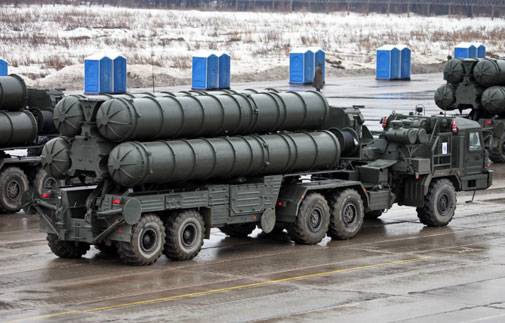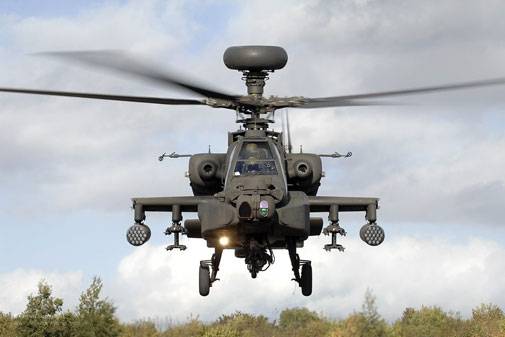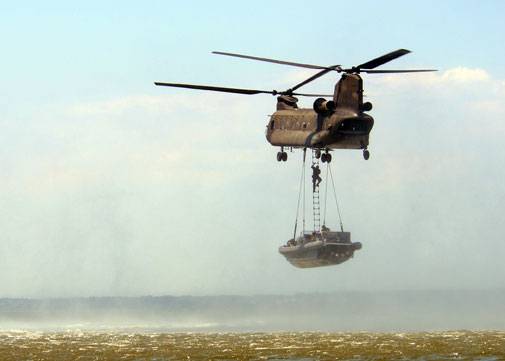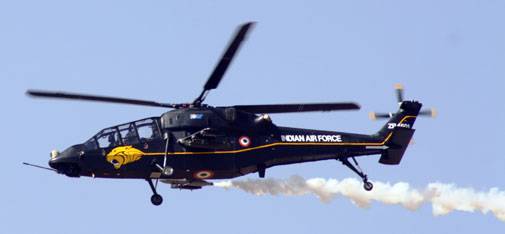Currently, India is surely among the top ten world powers in their military capabilities. The Indian armed forces are inferior armies of the United States, Russia and China, but still very strong and numerous. In another way, in a country with a population of about 1.3 billion people and could not be. The level of military spending in 2014, India was on the 7th place in the world - $ 50 billion (data Stockholm International Peace Research Institute). In the armed forces of India is more than 1.3 million people (3 in the world). Speaking of the armed forces of India, it is worth remembering that India is the world's largest importer of arms (as of 2012), as well as the possession of nuclear weapons and their means of delivery.
In addition to direct the armed forces, in India there are various paramilitary groups, which serves about 1.1 million people: the national security forces, border guards, special, special paramilitary forces. As of 2015, India's population of 1 billion 276 million people (2nd in the world's population, after China). At the same time mobilizing the resources of the country are estimated at least 270 million people, of which 160 million are eligible for military service.
The Indian armed forces are for the defense of the Republic, protection of the freedom and independence of the country, it is one of the most important instruments of political power. The personnel of the Indian armed forces has a high level of moral and psychological combat training and has been serving on a contract basis, compulsory recruitment into military service in India is missing. For India, because of the huge population and a complex ethnic and religious situation of the armed forces staffing at the call just is not possible.
Speaking of the armed forces of India, it should be noted that they are relatively young. The armed forces of the independent Republic of India, have appeared only in 1947. At the same time they were formed on the basis of troops who moved to the country when it was divided into two British Dominion - Indian Union and Pakistan. In the armed forces of India came to the part of personnel, Hindus and other religions except Islam and the Pakistani army troops have included Muslims. The official date of the formation of the national armed forces in India is considered to be August 15, 1949.
The peculiarity of the Indian armed forces is very close cooperation with the Russian military-industrial complex. On the Indian army is a huge amount of military equipment and weapons systems of production of the Soviet Union and Russia. For example, the world's largest fleet of T-90 tanks has not Russia, namely India. At the same time, both countries are actively cooperating in the military-technical sphere, carrying out joint development of a variety of weapons. Currently, India is a major importer of Russian weapons, while at the same time, the country is quite working closely with Britain, France and most recently with the United States.
Currently, the Russian-Indian cooperation is the exclusive nature. It is not that India for decades in Russia buys weapons. New Delhi and Moscow are working together on the creation of modern weapons systems, and quite unique, such as a missile "Brahmos", or fighter of the 5th generation - FGFA. Has no analogues in the world and surrender to lease a nuclear submarine (Russia gave India rent submarine "Nerpa" for 10 years), similar to the experience in this area was in the Soviet Union in the 1980s with the same India.
At the same time, India has its own military-industrial complex, which is able to produce weapons and equipment of all classes, including nuclear weapons and their means of delivery. However, this is more in theory as created in India armaments tend to have lower performance characteristics compared with foreign counterparts, and their development is decades. The most obvious example in this regard - it is an Indian tank "Arjun", the development of which lasted about 37 years. Not the most reliable and are collected in the country of foreign licenses models of equipment. For example, experts note that the high accident rate in the Indian Air Force may be associated with this factor. However, despite all of the above, India has everything to already in the XXI century to become one of the world's superpowers.
Indian Army
Indian Army are the largest component of the country's armed forces, they have served at least 1.1 million people (there are 990,000 reservists). In a part of the Army Training Command have (headquarters in Shimla), as well as six regional commands - Central, North, West, South-West, South and East. In the direct supervision of Army Staff of India is the 50th Airborne Brigade, two regiments of PU IRBM "Agni", one regiment PU OTP "Prithvi-1" and four regiments, armed cruise missile "Brahmos".
Indian Army are composed of 12 headquarters of the army corps, 36 divisions (18 infantry, 3 armored, division 4 rapid deployment, 10th Mountain Infantry and one Artillery). In addition, as part of ST, there are 15 separate brigades (armored 5, 7 infantry, two mountain-infantry and one airborne) and 12 air defense brigades, 3 engineering team and 22 army aviation helicopter squadron.
Currently, India has a fairly impressive tank fleet, which is mostly equipped with modern machines. The army delivered 124 tanks of its own design, "Arjun", is scheduled to deliver another 124, while work is under way on a modernized version of "Arjun-2." Also in 1250 the army has modern Russian MBT T-90 is planned to produce another 750 licenses for these tanks. Also available up to 2400 MBT Soviet T-72M, which have been or are being modernized. In addition, the storage of up to 1100 is the old tanks "vijayanta 'own production (the British" Vickers "Mk1), and up to 700 Soviet T-55 tanks.
In contrast to tanks with the rest of weaponry, everything is much worse. Basically the park is another Indian armor obsolete. The country has about 100 BRDM-2, about 1,200 BMP-2 and up to 300 different APC. Currently, the park upgraded BMP-2. In 2006, 123 cars were transformed into a version of the BMP-2K, armored vehicles are collected under the Russian license in India, and the Indian Defense Ministry plans to buy another 149 BMP-2K.
It is outdated and most of the Indian artillery. The army has 100 ACS 'Catapult' own design - 130 mm Howitzer M-46 tank chassis "vijayanta", and about 80 of these machines is in storage. There is also a 110 Soviet 122mm self-propelled guns 2S1 "carnation" and the English 80 105 mm self-propelled guns, "Abbot." Interestingly, in September 2015, India conducted a tender for procurement of 155-mm self-propelled guns, which won a victory in the South Korean artillery system K9 Thunder, bypassed Russia ACS "MSTA-S". This South Korean SAU definitely enjoyed success on the international market, it also has been selected as the primary and in the armed forces of Turkey. Manufacturing K9 Thunder self-propelled guns will be deployed in India, it is reported that the armed forces will buy at least 500 of these self-propelled guns.
In addition, the arms are about 4300 of towed guns of various calibers, more than 3 million in storage and order 7000 mortars. Modern samples of them as almost none. At the same time in 2010, India is trying to acquire the US 145 light 155 mm howitzers M-777, the deal has been discussed for 5 years, but it seems that in May 2015 the case moved from the dead point and howitzers will be delivered to the country.
Similar in the availability of new types of situation and MLRS. In India, there are about 150 Soviet BM-21 "Grad" (122 mm), 80 MLRS proprietary "Pinax" (214 mm) and 62 Russian systems "Smerch" (300 mm). The "Pinax" and "Twister" can be attributed to modern multiple rocket launchers.
Also armed with ground forces is about 250 anti-tank systems "Cornet" Russian-made 13 self-propelled anti-tank systems "Namik" (Indian ATGM "Naked" on the chassis of the BMP-2), in addition to this there are several thousands of Soviet and Russian ATGM "Baby", "Fagot" , "Competition", "Storm", the French anti-tank systems "Milan".
The basis of the army air defense constitute a Soviet / Russian air defense missile systems "Strela-10" (250), Wasp (80), "Tunguska" (184), "Shilka" (75), as well as Indian SAM short range "Akash" (300). On arms of Army Aviation has about 300 helicopters, mostly of Indian origin.
Indian Air Force
By the number of aircraft the Indian Air Force is in fourth place in the world after the US, Russia and China. In the Air Force has about 1,800 aircraft of all types, including about 900 combat vehicles. The Indian Air Force are serving about 150 thousand people. Organizational they are an integral part of the combined of the armed forces - air force and air defense (AD). Air Force has 38 staffs aircraft wings and 47 squadrons of combat aircraft, the country has an extensive network of airfields.
The headquarters of the Indian Air Force consists of the following departments: operational planning, intelligence, training, electronic warfare, weather, finance and communications. Also staff are subject to 5 Air Command and one training (headquarters in Bangalore), which directs and Air Force units in the field: Central (Allahabad), West (New Delhi), East (Shillong), Southern (Trivandrum) and Southwest (Gandhinagar).
A major problem of the Indian Air Force for many years is a high accident rate. Since the beginning of the 1970s to the early 2000s, the Indian Air Force every year lost an average of 23 aircraft and helicopters. At the same time the highest number of flight accidents falls on the Soviet MiG-21, which were produced in India, and has long formed the backbone of its fleet. The Indian Air Force, these aircraft have earned a reputation as "flying coffins" and "vdovodelov." From 1971 to April 2012 in India of fighter crashed 482 (more than half of the 872 MiG-21, which were obtained by India). At the same time in the ranks remains no less than 150 of these vehicles, 120 of which are planned to operate at least until 2019.
In general, make up the basis of the Indian Air Force planes and helicopters of Soviet / Russian origin. Strike aircraft was presented by the Soviet MiG-27 (113 cars), most of them are planned to be written off in 2015, and about 120 British fighter-bombers "Jaguar". All of these aircraft were built under license in India today are outdated.
Much better is the case with fighter aircraft. The air force has about 220 advanced Russian Su-30MKI, the total number will be increased to 272. According to the number of ranks in the Su-30 Indian Air Force bypass the Russian Air Force. Also available in service 62 MiG-29, all of them were upgraded to versions of the MiG-29UPG (53) and MiG-29UB-UPG. In addition, there are 50 French fighters "Mirage 2000" and another 11 such training machines. It is planned to upgrade them to the level of "Mirage 2000-5", which will extend the period of operation for another 20 years. In addition, the Indian Air Force begins to receive light multipurpose fighter of the fourth generation of its own design - HAL Tejas, built in 2014. 14 fighters, including prototypes. Total for the Indian Air Force plans to build about 200 such aircraft, which should replace the MiG-21 and MiG-27.
Has India and AWACS aircraft, there are three Russian A-50EI and three aircraft DRDO AEW & CS joint Indo-Brazilian development. It also has three US aircraft electronic intelligence "Gulfstream-4", six Russian air tankers Il-78 will be delivered another 6 European Airbus A330 MRTT.
As there are 17 transport aircraft Il-76MD, 105 An-32, part of the aircraft from 2009 modernized in Ukraine, and the rest will be upgraded directly in India. At the same time, India is planning to replace all Soviet Il-76MD, which operated for more than 28 years, the latest American transports the C-17 Globemaster III. In 2010, a contract was signed for the purchase of 10 aircraft, with a possible option to purchase another 6 cars. The first aircraft was handed over to the Indian Air Force in January 2013.
The Air Force is about 30 combat helicopters, including 24 Russian Mi-35 helicopter of own production 4 "Rudra" and 2 LCH. In addition, about 360 operated multipurpose and transport helicopters, among them a large number of Soviet Mi-8 and Mi-17 Russian Mi-17V5 and the Mi-26.
Indian Navy
Indian Navy include navy, naval aviation and special purpose units. Currently, the fleet is about 58 thousand people, including about 1200 in the Marines and about 5,000 in naval aviation. In service is more than 180 ships and 200 aircraft. For deployment of warships of the Indian Navy used three main naval base - Kadamba (near Goa), Mumbai and Vishakhapatnam. At the same IUD it includes in its membership three Command - West (Bombay), South (Cochin) and Eastern (Vishakhapatnam).
As part of India's submarine fleet is one SSBN 'Arihant' own development with 12 SLBM K-15 (range 700 km), proposed to build three submarines of this type. This launch range missiles rather modest. Also, leasing is a Russian nuclear submarine "Nerpa" Project 971, which received the Indian name "Chakra". In addition, in a system is 9 Russian diesel submarines of Project 877 "Halibut" and 4 German submarine project 209/1500. Also under construction 3 modern French submarines "Skorpen" all plans to build six such submarines.
Currently, as part of the Indian Navy has two aircraft carriers - "Viraat" (former English "Hermes") and "Vikramaditya" (formerly Soviet "Admiral Gorshkov"). Besides being the construction of two aircraft carriers of its own "Vikrant". In arsenal of naval aviation in India has 63 carrier-based fighter - 45 MiG-29K (including eight combat-capable MiG-29KUB) and 18 "Harrier". MiG-29K is designed to arm the aircraft carrier "Vikramaditya" (Fleet Air Arm - 14-16 MiG-29K and four MiG-29KUB, 10 helicopters), and construction of aircraft carriers of the "Vikrant", "Harriers" used to "Viraat".
ASW aircraft represented the old Soviet IL-38 - 5 aircraft Tu-142M - 7 aircraft (one for storage) and three modern American P-8I (all 12 were ordered). In addition, the Indian naval aviation has 12 Russian helicopter Ka-31 AEW, 41 anti-submarine helicopter, including 18 Soviet Ka-28 and Ka-25, 5, and 18 British "Sea King" Mk42V.
Surface naval forces quite unsuited. There are 9 destroyers, 5 such as "Rajput" (Soviet project 61), 3 of their own such as "Delhi" and one of the "Calcutta" (will be built 2-3 destroyers of this type). Also in the line is 6 modern Russian-built frigates of the "Talwar" (Project 11356), and 3 more modern self-built type "Shivalik". The navy has a new corvette "Kamorta" (to be built from 4 to 12 units), 4 corvettes of the "bark" type 4 "Hukri" type 4 "Abhay" (Soviet project 1241P). It is worth noting that all of destroyers, frigates and corvettes (except "Abhay") of the Indian armed fleet of modern Russian and Russian-Indian cruise missiles, sea-based anti-ship missiles and "Caliber", "BrahMos», X-35.
Nuclear power in India
In the structure of the armed forces of India to manage existing nuclear forces it has created a special structure - NCA (Nuclear Command Authority), Administration of the nuclear command. However, this management body, not only military but also political and military. This command to deal with nuclear planning in the interests of defense, and is responsible for making and implementing decisions on the use of nuclear weapons to repel foreign aggression led command is the prime minister of the country.
Bodies of military operational and technical management, directly subordinate to the chairman of the NCA and the Joint Chiefs of Staff of the armed forces of India, is the SFC - Strategic Forces Command, Strategic Forces Command, which was established in 2003. This command is responsible for the coordination of nuclear components Army and Air Force of the country, represent parts of the ground forces, equipped with ballistic missiles and ground-based aviation squadron, military aircraft carrying nuclear bombs. In the foreseeable future SFC will take over the control and created the naval strategic nuclear forces of India.
Most of the nuclear missile potential is concentrated in the Indian Army, which has two regiments of 8 PU medium-range ballistic missile "Agni". In total, presumably in India has 80-100 missile "Agni-1" (700-900 km), 20-25 missile "Agni-2" (2000-3000 km) and a number of extended-range ballistic missiles such as "Agni- 3 "(3500-5000 km). Also in a single regiment tactical missile "Prithvi-1" (150 km) with 12 PU for these missiles. All of these missiles could carry both conventional warheads, and nuclear. The carriers of nuclear weapons in the Indian Air Force may be a Russian Su-30MKI and the French "Mirage 2000".
Experts estimate that today India has a limited stock of nuclear weapons, combat ready - about 30-35 charges. In the country there is a certain amount of ready-made components for the assembly of the new charges. It is believed that in case of need rather quickly India can still make 50-90 nuclear warheads.






 decision now foreign cos including Russian can open 100% owned subsidiary in india without having to share technology
decision now foreign cos including Russian can open 100% owned subsidiary in india without having to share technology 
 image hosting over 2mb
image hosting over 2mb temporary image hosting
temporary image hosting how to take a screenshot on a pc
how to take a screenshot on a pc pic host
pic host free image uploading
free image uploading image hosting 10mb limit
image hosting 10mb limit